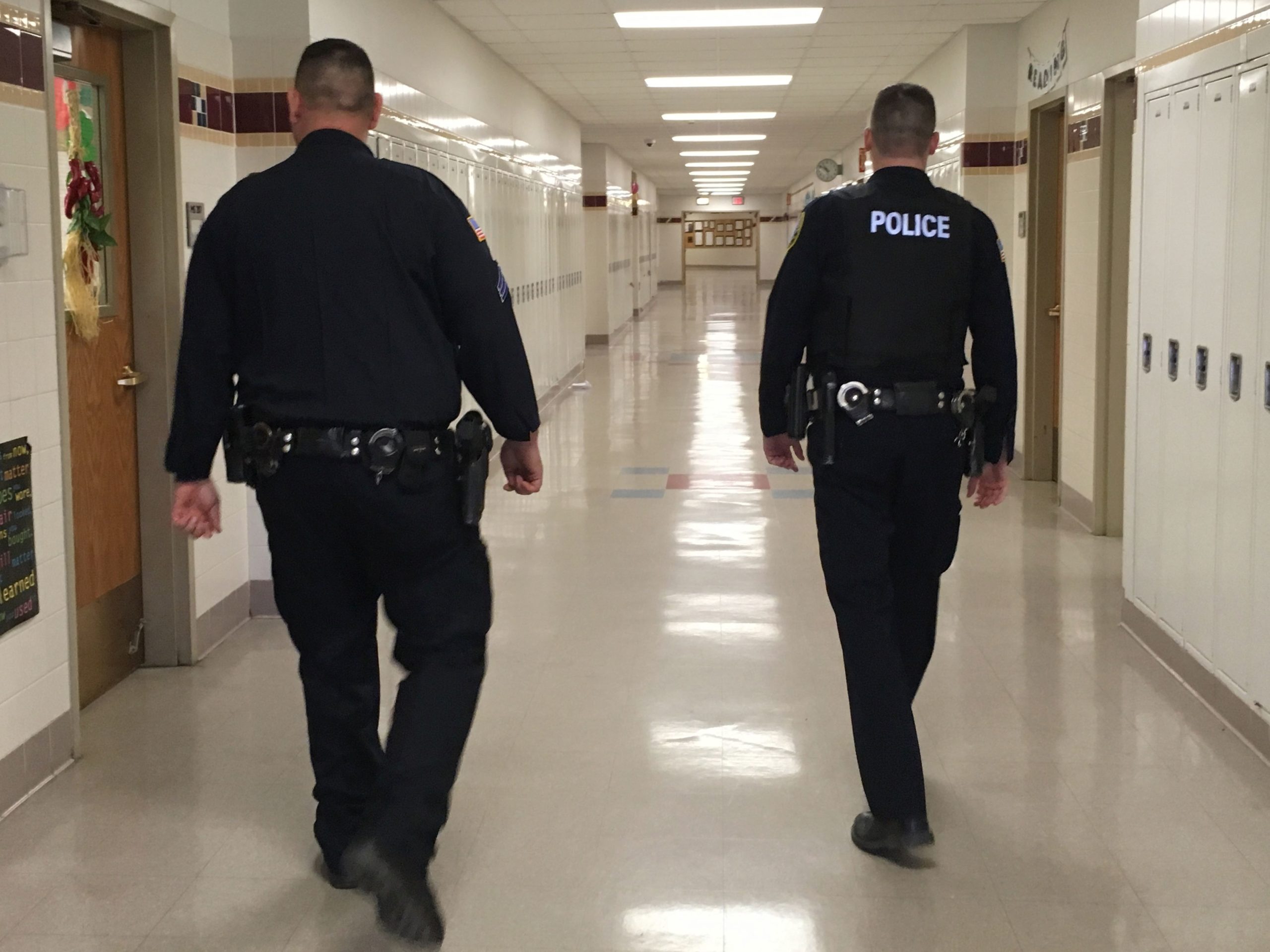Political Report
School Board Elections Are Confronting the School-to-Prison Pipeline
In Prince George’s County, Maryland, a push to remove armed police from schools could hinge on the outcome of local school board races.

In Prince George’s County, Maryland, a push to remove armed police from schools could hinge on the outcome of local school board races.
The criminal legal system is closely entangled with schools and education policy. This article is the first in a three-part series, in the run-up to Nov. 3, about local elections where education issues are at stake.
—
Since George Floyd was killed in Minneapolis police custody in late May, leaders in Prince George’s County, Maryland, have faced pressure over the 33 armed police officers who patrol the county’s public schools.
Other jurisdictions are having similar conversations, and school boards in places like Minneapolis, Portland, Milwaukee, and Denver have voted to end their contracts with local law enforcement agencies. “Policing doesn’t solve social problems, it can only disappear people,” says Christopher Rogers, a steering committee member of the Black Lives Matter at School coalition, which backs removing and defunding school police.
In many districts, including Prince George’s County, the November election will reshape these powerful school boards, and the issue of police in schools is paramount in some of these local races.
In June two Prince George’s County school board members—David Murray and Raaheela Ahmed—submitted resolutions to end contracts with local law enforcement agencies that station armed police, euphemistically referred to as “school resource officers,” or SROs, in all of the district’s high schools and some middle schools.
But instead of deciding on the proposals in mid-June, the board—a mix of 14 appointed and elected members, including a student member—voted 8-6 to delay consideration until September, ostensibly to spend more time collecting information and community feedback. But then September arrived, and the board voted, again 8-6, to table the idea until January.
Now two seats that are up for grabs in November might shift toward candidates who’ve said they would end the district’s ties with police. “The result of this election will literally have an effect on whether we will have armed police officers,” said Ahmed, who is running for re-election unopposed. “It could increase the vote count to eight in favor and the removal will happen.”
The prospect has sparked debate throughout the community. Before the June vote, County Executive Angela Alsobrooks, who was elected in 2018 after serving two terms as Prince George’s chief prosecutor, came out strongly against schools ending their agreements with local law enforcement agencies. Alsobrooks did not respond to multiple requests for comment, but at a June press conference she emphasized that teachers and students deserve robust protection from potential mass shooters. “I believe that we cannot afford to withdraw a single resource from our students,” she said. In early July, Alsobrooks announced a new police reform task force whose duties involve recommending how to improve policing throughout the majority-Black county.
The Maryland Office of the Public Defender weighed in on the other side, issuing comments in support of the proposals to remove armed police.“As we see every day in our work, the presence of SROs directly impacts the school to prison pipeline, easily funneling black students into the criminal legal system,” the office’s statement said. “The mere presence of an armed, uniformed officer changes the learning setting and escalates simple disagreements, contributing to a culture of criminalization and antagonism in schools.”
Ahmed thinks Alsobrooks’s opposition influenced the board’s politics. “We had enough information in June, and we had enough information in September to make this call,” she said. Ahmed added that she thinks some of her colleagues are afraid to take action “as opposed to actually believing that we need police officers, and that’s super disheartening.”
One candidate vying to serve a second term is Bryan Swann, who Alsobrooks appointed this year. Swann, a former Obama administration official who now works at the U.S Treasury Department, voted in June and September to postpone consideration of the school police issue. He’s facing off against Shayla Adams-Stafford, a career educator who earned 42.6 percent of the vote in the June primary, compared to Swann’s 26.6 percent.
“I believe that we need to end the school-to-prison pipeline and that includes removing armed officers from schools,” Adams-Stafford told The Appeal: Political Report. “Our county has some of the highest rates of student arrests. … We need to utilize restorative practices, and positive behavioral intervention systems in order to reduce the need for punitive measures within our schools.”
Removing armed police won’t necessarily cut arrests in schools significantly. In addition to the 33 armed police officers from law enforcement agencies, Prince George’s County Public Schools also employs security officers, 66 of whom also have arrest power but do not carry weapons.
During the 2019-20 school year, according to district data, there were 280 arrests of students for alleged crimes committed on and off school properties, and the vast majority of those arrests—204—came from the school district security officers. The armed police, by contrast, made 32 arrests. The top three reported crime categories were fighting, weapons other than guns, and “disruption,” all of which can encompass incidents that schools have historically dealt with through detention and other non-carceral strategies. Advocates concede that cutting ties with law enforcement agencies won’t be enough to end the school-to-prison pipeline but argue that at least the security officers are directly accountable to the district, so advocates can more easily target them for reform.
Another board member who had voted to postpone consideration was K. Alexander Wallace, but he lost his District 7 primary in June. Both candidates facing off for Wallace’s seat say they will vote to end contracts with armed school police officers.
Alexis Nicole Branch, who earned 39 percent of the vote in that primary, told the Political Report that she was “highly disappointed” with the board members who declined to vote against removing armed police.
“I was born, raised, and graduated from Prince George’s County schools and when I entered schools and saw police officers, it was terrifying for me,” she said. “And when I was dealing with bullying, those police officers didn’t help me at all. And when I wanted to see a counselor there was no one available to speak to me.” Branch notes that she has law enforcement in her family and “understands and respects” their work ethic but emphasized that they do not need to be around children “who are already intimidated by police officers on a regular basis.”
Kenneth Harris, who earned 44.5 percent of the vote in the District 7 primary, told the Political Report that he stands with other Prince George’s County school board members who have supported the removal of armed police officers. “As a product of the school system and a proud father, I want the absolute best for my child and others in the school system,” he said. “That starts with investing more in counselors, creating revised safety plans, and removing armed police from our schools.”
There are other school board races this cycle: In District 1, Murray—the other sponsor, with Ahmed, of the resolutions to remove armed police––is running unopposed for re-election. And in District 8 there is a contested but not very competitive race between incumbent Edward Burroughs, who supports removing armed police, and Gary Falls, a long-shot candidate who says armed police should stay in schools.
Alvin Thornton, the appointed Prince George’s County school board chairperson, told the Political Report that although he voted to table the issue until January, he is personally strongly opposed to armed police being in school environments. “I have three grandchildren in the school system, I don’t want any armed officers in those buildings,” he said. “But we need a comprehensive county and statewide response of which the school system will be part.” He pointed to the county task force on police reform and said he felt comfortable waiting until the winter to get its members’ feedback. “I’m the Black chairman of a school district that is majority-Black,” Thornton added. “I’m 72 years old, I know what police brutality is.”
Sonya Williams, an elected board member who also voted to postpone the decision until January, said she supported taking the time to move on this issue more slowly and deliberatively. “Change does not happen immediately and those who believe we were just kicking the can down the road, well I’m sorry they think that way,” said Williams, who represents District 9. “I supported us putting this on pause because it’s a big, big conversation and I wanted to make sure we look at the operational impacts, and the financial impacts.”
Williams noted that the board has directed the district’s CEO, Monica Goldson, to talk with stakeholders—including principals and teachers. “In my opinion, high schools in my district have good relationships with their SROs, they are part of the family of those schools,” Williams said. “But what options are there other than arrest? Diversion programs? Conflict resolution? Mental health, maybe telemedicine? These are things we’ve asked Dr. Goldson to review for us.”
Janna Parker, a former educator and a public education advocate in the county, says board members had “more than enough” information and time to take action already. “They’re trying to play this waiting game, trying to wait it out,” she said.
Other community activist groups, like PG Change Makers Coalition, have been ramping up pressure on leaders to end contracts with armed officers in schools. And the Advancement Project, a national civil rights organization, also came out in support of removing armed police from Prince George’s County schools.
Over the summer, school board members collected dozens constituent responses on whether to keep armed police in schools. Reactions varied with some parents and community members very supportive of removal, while others urged the board to keep SROs in schools for safety reasons.
Doris Reed, the director of the Association of Supervisory & Administrative School Personnel, urged strongly against their removal. “If your proposed actions are carried out, the burden of total school security would then shift to our school Administrators,” she wrote.
The Prince George’s County Police Department told the board that the department “welcome[s] a dialogue with the School Board regarding it[s] concerns about School Resource Officers” and noted that such concerns “have not been voiced previously.”
In terms of existing research evidence, Chalkbeat reporter Matt Barnum found that some studies do suggest that the presence of school police increases suspensions and arrests, particularly for young students, but there is no clear answer from the available literature on whether police reduce school crime or major conflict. Student surveys of school police tend to be generally positive, Barnum found, though among Black students they’re markedly more negative.
Though the debate continues, nearly everyone agrees there needs to be more focus on addressing the root causes of harm and conflict in schools. “We’ve seen the defunding of the essential services of guidance counselors, nurses, and librarians in schools that serve a majority of Black children,” said Rogers of the Black Lives Matter at School coalition. “We believe that reinvesting into these roles which nurture children and families is much more important in fulfilling the objectives of education and the sustaining of community.”
